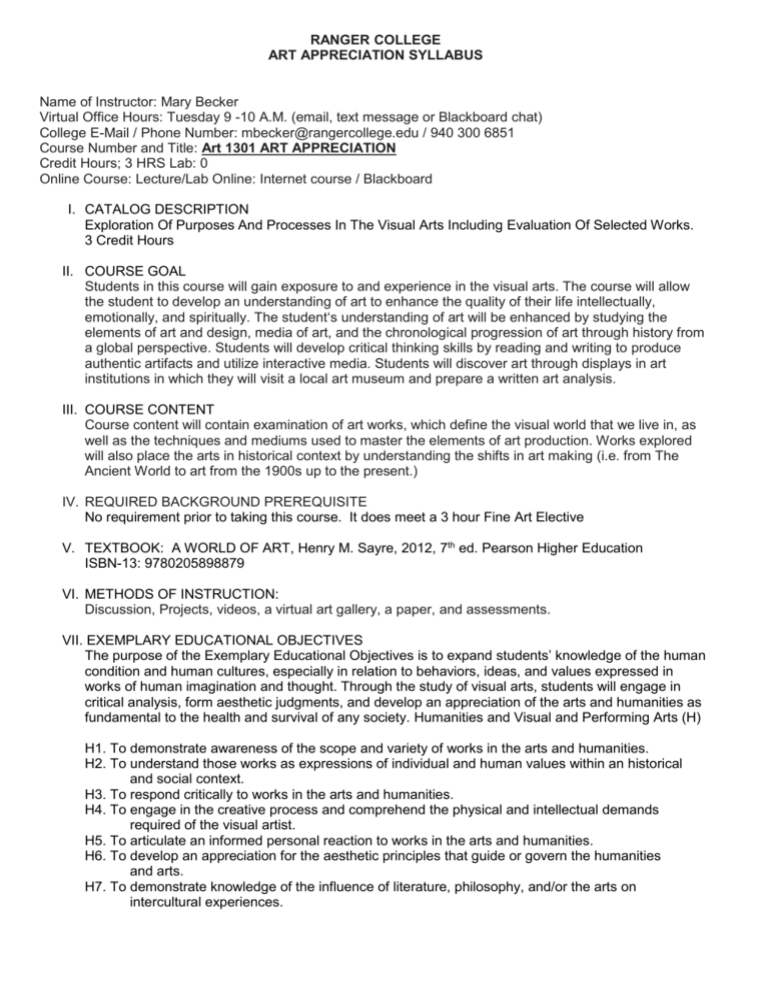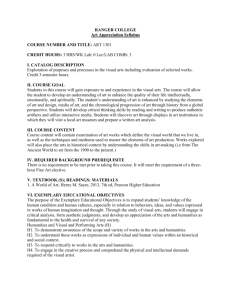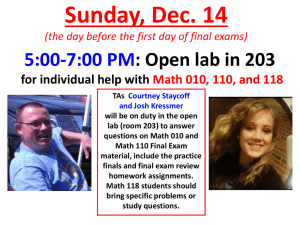RANGER COLLEGE ART APPRECIATION SYLLABUS Name of
advertisement

RANGER COLLEGE ART APPRECIATION SYLLABUS Name of Instructor: Mary Becker Virtual Office Hours: Tuesday 9 -10 A.M. (email, text message or Blackboard chat) College E-Mail / Phone Number: mbecker@rangercollege.edu / 940 300 6851 Course Number and Title: Art 1301 ART APPRECIATION Credit Hours; 3 HRS Lab: 0 Online Course: Lecture/Lab Online: Internet course / Blackboard I. CATALOG DESCRIPTION Exploration Of Purposes And Processes In The Visual Arts Including Evaluation Of Selected Works. 3 Credit Hours II. COURSE GOAL Students in this course will gain exposure to and experience in the visual arts. The course will allow the student to develop an understanding of art to enhance the quality of their life intellectually, emotionally, and spiritually. The student‘s understanding of art will be enhanced by studying the elements of art and design, media of art, and the chronological progression of art through history from a global perspective. Students will develop critical thinking skills by reading and writing to produce authentic artifacts and utilize interactive media. Students will discover art through displays in art institutions in which they will visit a local art museum and prepare a written art analysis. III. COURSE CONTENT Course content will contain examination of art works, which define the visual world that we live in, as well as the techniques and mediums used to master the elements of art production. Works explored will also place the arts in historical context by understanding the shifts in art making (i.e. from The Ancient World to art from the 1900s up to the present.) IV. REQUIRED BACKGROUND PREREQUISITE No requirement prior to taking this course. It does meet a 3 hour Fine Art Elective V. TEXTBOOK: A WORLD OF ART, Henry M. Sayre, 2012, 7th ed. Pearson Higher Education ISBN-13: 9780205898879 VI. METHODS OF INSTRUCTION: Discussion, Projects, videos, a virtual art gallery, a paper, and assessments. VII. EXEMPLARY EDUCATIONAL OBJECTIVES The purpose of the Exemplary Educational Objectives is to expand students’ knowledge of the human condition and human cultures, especially in relation to behaviors, ideas, and values expressed in works of human imagination and thought. Through the study of visual arts, students will engage in critical analysis, form aesthetic judgments, and develop an appreciation of the arts and humanities as fundamental to the health and survival of any society. Humanities and Visual and Performing Arts (H) H1. To demonstrate awareness of the scope and variety of works in the arts and humanities. H2. To understand those works as expressions of individual and human values within an historical and social context. H3. To respond critically to works in the arts and humanities. H4. To engage in the creative process and comprehend the physical and intellectual demands required of the visual artist. H5. To articulate an informed personal reaction to works in the arts and humanities. H6. To develop an appreciation for the aesthetic principles that guide or govern the humanities and arts. H7. To demonstrate knowledge of the influence of literature, philosophy, and/or the arts on intercultural experiences. VIII. BASIC INTELLECTUAL COMPETENCIES The Basic Intellectual Competencies listed below are essential to the learning process designed to assist and prepare the students for becoming well-educated individuals who are intellectually flexible, articulate, and have the capacity to become responsible and creative mentors of society. These competencies are included in this course and they are noted by the following numbering system. B1. READING: The ability to analyze and interpret a variety of printed materials -- books, articles, and documents. B2. WRITING: The ability to produce clear, correct, and coherent prose adapted to purpose, occasion, and audience. B3. SPEAKING: The ability to communicate orally in clear, coherent, and persuasive language appropriate to purpose, occasion, and audience. B4. LISTENING: The ability to analyze and interpret various forms of spoken communication. B5. CRITICAL THINKING: The ability to embrace methods for applying both qualitative and quantitative skills analytically and creatively to subject matter in order to evaluate arguments and to construct alternative strategies. B6. COMPUTER LITERACY: The ability to use computer-based technology in communicating, solving problems, and acquiring information. VIIII. COURSE OBJECTIVES 1. Recognize the various media used in art. (H1)(B1) 2. Visually identify works by major artists from the various movements of art. (H2)(B1)(B6) 3. Understand the development and context within various styles of art. (H3)(B1)(B2) 4. Become familiar with the formal techniques used within art-making. (H6)(B1) 5. Comprehend the influence of our visual world. (H7)(B1)(B4) 6. Develop an understanding of reading images through visual literacy. (H3)(B5)(B6) 7. Become knowledgeable of placing art into historical and cultural context. (H2)(H7)(B4) 8.Visit a local art museum and produce a written art analysis on their discovery. (H5)(B2) 9. Engage in hands-on projects that help students to comprehend the creative process. (H6)(B5) 10. Express personal views on current art practices or influences in our culture. (H5)(B2) X. COURSE CALENDAR This schedule is tentative and subject to change depending upon the progress of the class Week 1: 1st day of class Read the Syllabus; Print calendar found under “To Succeed in this class”. Write your paper introducing yourself to me and remember to include your educational goals. Read Chapter 1 /watch videos; Do the Black Board assignment that will help you find your way around the Art Appreciation, Blackboard website. Goals and Aspiration Paper Due Read Chapters 1 & 3 / watch videos; Do the discussion assignments. Quiz for Chapter 1 and 3 DUE Week 2: Read Chapters 2 / watch videos Do the discussion assignments. Quiz for Chapter 2 is DUE Read Chapters 4, & 5 / watch videos Week 3 Quiz on Chapters 4, & 5, DUE Do the discussion assignments. Read Chapter 6 and watch videos Do the discussion assignments. Quiz on Chapter 6 DUE Week 4 Read Chapter 7 & 8 and watch videos Quiz for Chapters 7 & 8 DUE Week 5 Exam 1 over Chapters 1 through 8 open book DUE Read Chapter 9, 10 & 11 / watch videos; Do the discussion assignment for chapter 10. Quiz for Chapters 9, 10, & 11 DUE Week 6 Read Chapter 12/ watch movie and videos Do the discussion assignments. Chapter 12 Quiz DUE Start 2D art work remember to take photos Week 7 2D Artwork DUE & Discussion about what you did and how it fits some of the elements and principals: Include photographs. Read Chapters 13 & 14/ watch videos; Quiz for Chapter 13 & 14 DUE; Week 8 Read Chapters 15 & 16/ watch videos Quiz for Chapter 15 & 16 DUE Week 9 Start the rough draft of your paper and start your 3D art work remember to document with photos Week 10 Mandatory: First draft of report due 3D Artwork DUE & Discussion about what you did and how it fits some of the elements and principals: Include photographs. Week 11 If less than an A on your Rough Draft you will want to start editing your Artist Report for the Final Draft only the highest grade is kept Exam 2 over Chapters 9 through 16 open book DUE Read Chapter 17 / watch videos; Week 12 Quiz on Chapter 17 Due Read Chapters 18 & 19 / Watch Videos; Week 13 Quiz for Chapter 18 & 19 DUE Read Chapter 20 and 21 / Watch Videos; Week 14 Exam 3 over Chapters 17 through 21 DUE Final Draft of Report Due of the 2 only the highest grade is kept Week 15 Any PREARRANGED make – up work is DUE Week 16 FINAL EXAM - [no notes and no book] proctored on Ranger Campus or your High School Contact instructor if special arraignments need to be made XI. ASSESSMENT: 50 points for Personal Goals Paper 100 points for personal experience paper on a visit to museum or art show may substitute artist report from books, magazines and web sites (not Wikipedia) 210 points for Quizzes 200 points for personal artwork 90 points for Discussions 400 points for Exams and Final 90 – 100% 80 – 89 % 70 – 79 % 60 – 69 % < 60% - A B C D F XII. COURSE/CLASSROOM POLICIES ADA Statement: Ranger College provides a variety of services for students with learning and/or physical disabilities. The student is responsible for making the initial contact with the Ranger College Counselor. It is advisable to make this contact before or immediately after the semester begins. Admissions, employment, and program policies of Ranger College are non-discriminatory in regard to race, creed, color, sex, age, disability, and national origin. All recruitment and admission material complies with Section 504 of the ADA. XII. ATTENDANCE As an Internet course - attendance and course participation are gauged based on your ability to complete all class assignments on time. Internet courses can be more extensive than regular face-to-face courses; you are required to demonstrate your progress in practical ways, such as posting on Discussion Boards, Quizzes, Exams and Essays. If you have not participated in the assignments for 3 weeks you may be dropped from the course. Please keep me apprised if you have a scheduling conflict that we can work around. As the instructor I reserve the right to make changes to the course to if necessary for the good of all.






